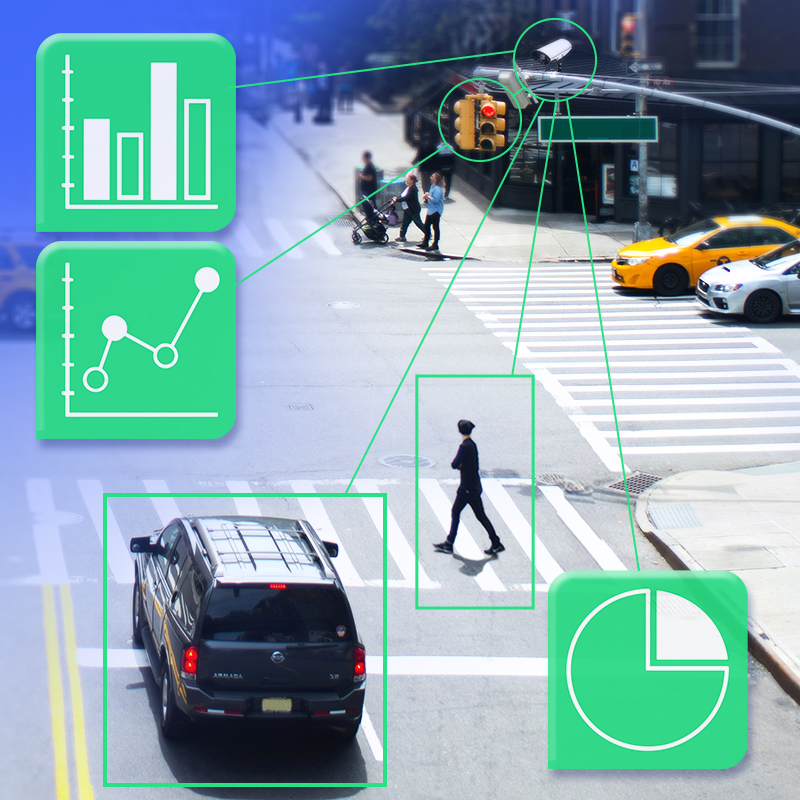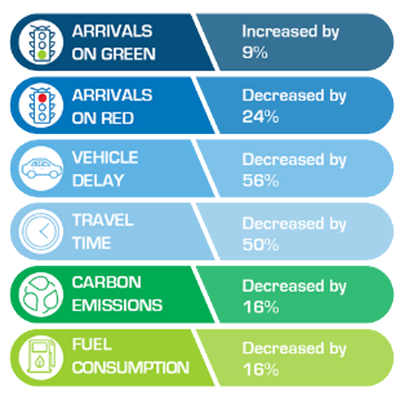Traffic Detection and Data Analytics: A New Era in Traffic Management
Traffic management is no longer just about controlling signals. It’s about understanding the dynamic nature of mobility and roadway conditions. With the rise of traffic detection analytics, AI-powered systems, real-time traffic data, and situational awareness, cities now have the tools to make more informed decisions that yield safer and more sustainable mobility. Intelligent multitasking traffic detection is transforming how we optimize mobility.

Advanced Detection Technologies: Video, Radar, Sensor Fusion, and AI
Modern traffic detection sensor systems rely on a blend of technologies to capture and interpret roadway activity. These systems provide the foundation for traffic data analytics, enabling agencies to understand patterns, predict congestion, improve safety, and optimize operations.
Video-Based Vehicle Detection Systems
Video detection has become a cornerstone of Intelligent Transportation Systems (ITS). High-definition cameras powered by AI algorithms can:
- Detect and classify vehicles, including bicycles
- Monitor and count pedestrians
- Identify vehicle movements and trajectories.
- Support vehicle detection system analytics for performance and safety
Radar and Sensor Integration
Radar detection excels in virtually all-weather conditions, providing accurate speed and volume data. When fused with video or other sensors, radar enhances detection reliability. For example, leading-edge sensor systems that integrate a video camera can track vehicles across multiple data streams, improving accuracy and reliability with fewer sensors.
This integration enables:
- Precise radar traffic detection data analysis with validation
- Enhanced tracking in complex environments.
- Cost-effective deployment at complex intersections and corridors.
AI and Edge Processing
AI-powered traffic detection is revolutionizing how cities manage congestion. By processing data at the edge, systems can significantly reduce latency and enable real-time decision-making. This helps to foster and support emerging:
- Predictive modeling of traffic patterns
- Dynamic signal control
- Safety countermeasures
A recent connected vehicle-focused Centracs® Edaptive deployment with Signal Performance Measures (SPM) yielded significant and measurable results. The traffic signal optimization solution included new Econolite’s Cobalt® advanced traffic controllers powered by EOS firmware and detection sensors. The measurable improvements included:
- 56% reduction in vehicle delays
- 50% improvement in travel times
- 24% decrease of arrivals on red
- 16% decrease in carbon emissions
- 16% decrease in fuel consumption

Intersections, Corridors, and Freeways: Analytics in Every Context
Traffic detection analytics apply across all roadway types, offering tailored insights for each traffic monitoring system environment. It helps cities focus on the metrics that matter.
- Detection of vehicle-to-vehicle and vehicle-to-VRU conflicts
- Evaluation of roadway and intersection geometries
- Prioritization of safety improvements based on collision and conflict rates
Arterial Corridor Flow Analysis
Corridors require coordinated traffic signal timing and flow optimization. Corridor traffic analysis uses data aggregated from multiple sensors and intersections to:
- Measure travel time, delay, and queue lengths
- Support traffic signal optimization
- Enable or trigger traffic signal adjustments based on real-time conditions
ITS tools like adaptive control, signal performance measures, and smart sensor systems help cities manage corridors and transportation networks for operational efficiencies and safety.
Freeway and Network Monitoring
Freeways demand robust detection for high-speed environments. Technologies like radar, video camera, and in-ground sensors provide:
- Real-time vehicle counts and speed measurements
- Ramp metering and queue flushing
- Incident detection and response coordination
These detection solutions integrate with traffic management centers to ensure seamless monitoring and oversight, as well as rapid intervention and data-driven planning and policy decision-making.
Benefits for Traffic Engineers, Agencies, and Decision-Makers
Traffic monitoring systems and traffic data analytics platforms help establish the foundation for Dynamic Multimodal Network Management, offering transformative benefits for the future of mobility:
- Data-Driven Decision Making: Engineers can evaluate interventions, forecast demand, and plan infrastructure upgrades based on data, as well as leverage modeling tools
- Safety Enhancements: Analytics help identify high-risk areas and support targeted improvements and implementing new data-driven applications
- Efficiency Gains: Real-time traffic flow analysis helps cities identify improvements that optimize roadways and mobility.
- Environmental Impact: Optimized traffic flow results in lower emissions and reduced fuel consumption.
- Public Engagement: Traffic data visualization tools help communicate performance, support connected messaging, and build trust with communities.
Whether it’s vehicle detection system analytics or traffic data visualization applications, these tools empower cities to deliver smarter mobility solutions.
Future-Ready Traffic Systems: From Connected Vehicles to Vision Zero
The future of traffic management and mobility depends on traffic data analytics, as well as integration, automation, and safety.
Connected Vehicle Integration
Vehicle-to-Everything (V2X) communications enable vehicles to exchange data with infrastructure, traffic management systems, other vehicles, and pedestrians. This supports:
- Real-time hazard detection and push notifications
- Adaptive signal timing based on vehicle presence
- Emerging connected and automated mobility applications
The systems that manage and communicate with connected vehicles also support traffic signal optimization. The connected vehicle systems help mitigate risks, improve traffic flow, identify hazards, and reduce intersection conflicts, aligning with Vision Zero goals.
Vision Zero and Safe Systems
Vision Zero views all traffic fatalities and serious injuries as preventable. The mission is to eliminate traffic-related deaths and injuries. Traffic detection analytics play a critical role by:
- Identifying high risk and crash-prone locations
- Supporting proactive safety interventions and roadway improvements
- Enabling continuous monitoring and evaluation
Emerging AI-powered systems and applications can forecast and predict roadway conditions, trigger safety countermeasures, as well as model and validate infrastructure investments that save lives.
Econolite: A Data-Centric Traffic Systems Leader
Econolite is at the forefront of intelligent traffic detection and analytics innovations. With nearly 100 years of experience and a commitment to pioneering ITS and data-driven systems, Econolite delivers solutions that support safer, smarter, and more sustainable mobility.
Centracs® +Detect Platform
Econolite’s Centracs +Detect is a cloud-based analytics and reporting solution that seamlessly integrates with Autoscope® OptiVu, Autoscope® Vision, and EPIQ RADAR™ sensor systems. +Detect provides:
- Real-time monitoring of traffic conditions
- Automated reporting of volume, speed, and turning movements
- Tools for signal retiming, system health monitoring, and environmental assessments
AI-Powered Safety and Optimization
Econolite’s ITS platforms support:
- Signal performance measures and KPI reporting
- Dynamic traffic signal operations
- Pedestrian detection analytics for multimodal safety
- Traffic-responsive safety event reporting
These capabilities help cities align with Vision Zero initiatives and deliver measurable improvements for modern data-driven transportation safety and efficiency strategies.
Smart Infrastructure and Services
From vehicle detection system analytics to connected vehicle data exchange, Econolite offers:
- ITS systems integration and engineering services
- Field maintenance and construction support
- Signals-as-a-Service and managed ITS services.
These capabilities help cities align with Vision Zero initiatives and deliver measurable improvements for modern data-driven transportation safety and efficiency strategies.
Building Smarter Mobility Through Data
Traffic detection and data analytics are shaping the future of Smart Cities and mobility. By leveraging the data and analytics from technologies like video and radar sensors, AI-powered applications, and edge computing, cities can make informed decisions that help bridge the gap to a Vision Zero future.
Econolite’s intelligent data-driven solutions empower cities to move toward Dynamic Multimodal Network Management, where roadways and intersections are proactively optimized for performance and safety.
Cabinets
Traffic Controllers
Systems Deployed
Sensors Installed
